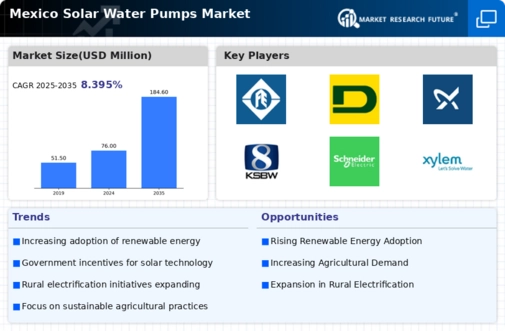Rising Energy Costs
The solar water-pumps market is likely to benefit from the rising energy costs in Mexico. As electricity prices continue to escalate, agricultural producers and rural communities are increasingly looking for cost-effective alternatives to traditional energy sources. Solar water-pumps present a viable solution, as they operate independently of the grid and incur minimal operational costs after installation. This shift not only reduces dependency on fossil fuels but also aligns with the growing emphasis on renewable energy. The financial savings associated with solar technology can be substantial, potentially leading to a market growth rate of over 15% annually in the coming years. This trend indicates a strong preference for sustainable energy solutions in the agricultural sector.
Increasing Water Scarcity
The solar water-pumps market is experiencing growth due to the increasing water scarcity in Mexico. As traditional water sources become depleted, farmers and communities are seeking alternative solutions to ensure a reliable water supply. The reliance on solar-powered systems offers a sustainable approach to irrigation and water management. In regions where groundwater levels are declining, solar water-pumps provide an efficient means of accessing water without the high operational costs associated with diesel pumps. This shift is particularly evident in arid and semi-arid areas, where the demand for innovative water solutions is rising. The market is projected to expand as more users recognize the long-term benefits of solar technology in addressing water scarcity challenges.
Government Policy and Regulation
The solar water-pumps market is influenced by favorable government policies and regulations in Mexico. The government has been actively promoting renewable energy initiatives, which include incentives for solar technology adoption. Programs aimed at reducing the carbon footprint and enhancing energy efficiency are encouraging farmers to invest in solar water-pumps. Additionally, the establishment of regulatory frameworks that support the installation and operation of solar systems is likely to enhance market growth. As of 2025, the government has allocated approximately $200 million to support renewable energy projects, which could significantly impact the solar water-pumps market. This supportive environment fosters innovation and investment in sustainable water solutions.
Technological Advancements in Solar Systems
The solar water-pumps market is benefiting from rapid technological advancements in solar systems. Innovations in photovoltaic technology and battery storage are enhancing the efficiency and reliability of solar water-pumps. These advancements allow for better performance in diverse environmental conditions, making solar solutions more appealing to users. For instance, the introduction of smart irrigation systems that integrate solar water-pumps with IoT technology is revolutionizing water management practices. This trend is expected to drive market growth as users seek more efficient and automated solutions for irrigation. The continuous improvement in solar technology could lead to a market expansion of approximately 20% over the next five years, indicating a robust future for solar water-pumps.
Growing Awareness of Environmental Sustainability
The solar water-pumps market is experiencing growth due to the increasing awareness of environmental sustainability among consumers and businesses in Mexico. As climate change concerns rise, there is a growing emphasis on adopting eco-friendly practices in agriculture and water management. Solar water-pumps offer a clean alternative to conventional pumping systems, reducing greenhouse gas emissions and promoting sustainable resource use. This shift in consumer behavior is likely to drive demand for solar solutions, particularly in agricultural sectors that are heavily reliant on water resources. The market could see a growth rate of around 18% as more stakeholders recognize the importance of sustainable practices in ensuring long-term viability and environmental stewardship.





















Leave a Comment